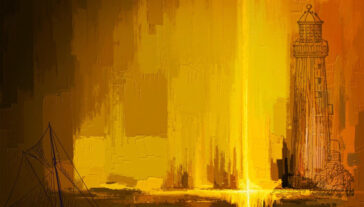Mythology Connections: Don’t Fly Too Close to the Sun

Mythology Connections is a series centered around mythology in UMMA’s collection. We all had at least one mythology phase — Greek, Roman, Egyptian, whatever struck your fancy. Books like Rick Riordan’s Percy Jackson and the Olympians series definitely had a hand in that for some of us, and now Madeline Miller’s Song of Achilles has joined the ranks. This series seeks to reignite that phase while making connections to the wonderful art in UMMA’s collection.
The sculpture pictured above is Charles Ginnever’s Daedalus, a Cor-Ten steel structure from 1975. It now stands on the South University side of UMMA, which, if you’re a student or Ann Arbor resident, you may have walked past on your way to the Michigan Union or South Quad.
Daedalus was a brilliant inventor in Greek mythology best known for his creation of the labyrinth on the island of Crete. According to the myths, King Minos of Crete forced him to create the labyrinth to hide the Minotaur – the horrible half-man, half-beast product of his wife’s infidelity. You may have heard about the labyrinth specifically in the context of the great Greek hero Theseus, who was sent by his father to slay the Minotaur. He navigated the labyrinth with the help of King Minos’s daughter, Ariadne, who gave him a ball of string so he could keep track of where he came from.
This particular sculpture, however, alludes to a later part of the story of Daedalus described by the ancient writer Ovid. In his Metamorphoses, Ovid tells us that Daedalus was tired of living under the direction of King Minos and hatched a plan to escape his prison with his son, Icarus. He created massive wings out of candle wax and feathers and set out, flying across the Mediterranean Sea. However, Icarus got swept up in the wonder of flight and drifted too close to the sun, causing the wax to melt and resulting in his death. Ginnever’s “Daedalus” mimics the shape of the wings. This scene is a popular subject in art, making an appearance in Jacob Matham’s Landscape with Shepherds Watching the Flight of Icarus and Daedalus, which is another work in UMMA’s collection.
In ancient writings, Daedalus is referenced in Homer’s Iliad and Virgil’s Aeneid, among other sources. In modern works, Rick Riordan centered the fourth book — The Battle of the Labyrinth — in his Percy Jackson and the Olympians series around Daedalus’s labyrinth, with the man himself appearing throughout the book.
I’ve walked past Daedalus a lot in my time at Michigan, but it used to just blend into the landscape for me. Exploring the context of the myth that inspired it helped me feel more connected to campus, so hopefully this can do the same for others!
More from UMMA


